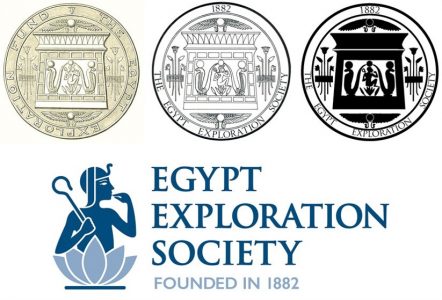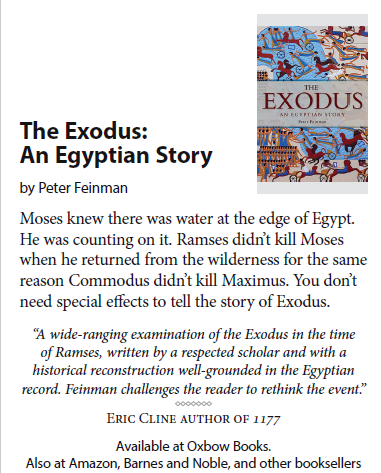
When I was researching The Exodus: An Egyptian Story, I learned to my surprise that when the Egyptian Exploration Fund (EEF), now the Egyptian Exploration Society (EES) was founded in 1882, the Exodus was a foundational goal. The Fund sought to find the route of the Exodus.
This interest in the Exodus can be traced to the concerns of the two founders, Amelia B. Edwards, author of A Thousand Miles Up the Nile, and Reginald Stuart Poole of the British Museum. Edwards’s story is a remarkable one in its own right. As a woman of no money and no formal training in Egyptology who had spent decades of her life in totally unrelated activities, her formidable presence in the world of Egyptology would have been a surprise to those who had known her.
Equally surprising would have been her commitment to find the route of the Exodus. From my own admittedly limited research, there is nothing in her earlier life to indicate this effort that would dominate the last decade of her life.
With Poole, the quest is not as surprising. At age 17, Poole had published Horae Aegyptiacae, or the Chronology of Ancient Egypt (1851). He supported an Egyptian chronology that was consistent with the biblical chronology of a 4004 BCE creation date. Poole became part of a vigorous debate in England in the 1850s about the antiquity of man. The debate initially was spurred by the geology of Charles Lyell. Biblical commentaries from the time include extremely lengthy small-print reconcilement of geology and Genesis.
Related to the date debate was the race one. The 1850s also was a time of pre-Adamite hypotheses. Part of the debate revolved around the separation of the Caucasian people in the Bible from the pre-Adamite people who had originated in the Nile Valley and spread throughout Asia and Africa. This information was not included in my book. However the whole topic of race and the antiquity of the human race or races was part of the intellectual background of one of the founders of the EEF. Egypt and the Bible were battlegrounds in the fight.
At that time, archaeology was seen as a weapon that would prove the Bible. The discoveries by Austen Henry Layard, Hendrich Schliemann, and George Smith all were examples of how archaeology could substantiate ancient texts. Then in 1882, there was an opening for the position of Professorship of Hebrew at Oxford. Samuel Rolles Driver who was more receptive to German Higher Criticism received the position. Archibald H. Sayce who would become a prolific writer on behalf of the monuments and the Bible did not. Sayce did however join a new organization.
Egypt Exploration Fund (EEF)
March 30, 1882
A society has been formed for the purpose of excavating the ancient sites of the Egyptian Delta…The general plan drawn out has received the approval of the Archbishop of Canterbury, the Bishops of Bath and Wells, Durham and Lincoln, the Chief Rabbi, Archdeacon Arson… (Egyptian Exploration Fund, “Egyptian Antiquities,” The Times, 30 March 1882, 8).
The religious affiliations of some the founders of the organization attest that the EEF was not simply an archaeological organization. Biblical religion was at the core of its identity.
Yet here [at Zoan-Tanis] must undoubtedly lie concealed the documents of a lost period of Bible history⸺documents which we may confidently hope will furnish the key to a whole series of perplexing problems.
The position of the Land of Goshen is now ascertained. The site of its capital, Goshen, is indicated only by a lofty mound; but under this mound, if anywhere, are to be found the missing records of those four centuries of the Hebrew sojourn in Egypt which are passed over in a few verses of the Bible, so that the history of the Israelites during that age is almost blank (Egyptian Exploration Fund, “Egyptian Antiquities,” The Times, 30 March 1882, 8).
Edwards took a leading role in promoting the biblical connection of the new organization. Indeed, Knowledge, a new popular science magazine first published in 1881, marketed the Exodus as a lure to potential readers.
Was Rameses II. The Pharaoh of the Oppression
In an early number, probably the next, an important series of papers by Miss Amelia B. Edwards, the eminent authoress and Egyptologist, on the question, “Was Rameses II. the Oppressor of the Hebrews” will be commenced. (Knowledge, May 12, 1882, 583)
A second promo appeared two weeks later.
In the next volume will appear the first of a most interesting series of papers by Miss Amelia B. Edwards placing beyond dispute or cavil the identity of the Pharaoh of the Oppression. (Knowledge, May 26, 1882, 617)
The discovery of the mummy of Ramses II in 1881 may have triggered the series.
Edwards authored a 16-part series from June 2, 1882, to Jan 19, 1883, on Ramses as the Pharaoh of oppression. She started with Joseph possibly under Pharaoh Apophis in the attempt to fill the story of the 430 year sojourn. I vaguely recall one of the sources also vaguely recalling that the series had been consolidated into a single pamphlet by someone. Regardless of the accuracy of Edwards’s analysis, it is an important historiographical source on the state of Exodus scholarship in England at the time, especially one based on Egyptian archaeology and not simply on biblical exegesis.
We have, at all events, the evidence of the Book of Exodus, and the testimony of several Egyptian documents, to show that, from the time of Ramesses II, when the new “treasure-city” was built and Goshen city ceased to be the chief town of the province, the old name of the Nome fell into either partial or complete disuse and the “land” or county of Goshen came to be called after its new capital, “the land of Ramesses.” (Knowledge, September 15, 1882, 260)
This quotation comes from “IX.- The Land of Goshen.” The area included the Wadi Tumilat which was the focus of the effort to locate the route of the Exodus. The first excavation authorized by the EEF was to find that route in that wadi. The excavation seemed to strike pay dirt for the fledging organization. The excavations quickly led to the publication of The Store City of Pithom and the Route of the Exodus by Edouard Naville (1885), the excavator.
Poole celebrated the discovery of “the very walls on which the enslaved Hebrews worked … It is the first step towards delineating the route of the Exodus” (“The Progress of Discovery in Egypt,” The Academy 23:563 1883:140). The bricks might even be for sale until he realized how big they were. (David Gange, Dialogues with the Dead: Egyptology in British Culture and Religion, 1822-1922 Oxford: Oxford University Press, 2013: 187)
In the meantime, Poole had published Cities of Egypt also in 1882. Edwards’s review of the book reveals the intentions of the founders of the EEF
Remembering the enthusiasm excited by the discovery of the Chaldaean Deluge-tablets [Gilgamesh Epic], one asks with wonder how that enthusiasm is compatible with our indifference to the far more momentous discoveries which await the Egyptian explorer…Such records are more vitally important than all the Deluge legends recently collected from every corner of the globe… (The Academy, December 2, 1882, 389)
In the review, Edwards was quite vigorous in calling the English flock to the task at hand.
[I]t is first of all needful to wake the Bible-loving, church- and chapel-going English people from their long sloth, and to make them see that now, if ever, it is a serious duty, and not a mere archaeological pastime, to contribute funds for the purpose of conducting excavations on a foreign soil. (The Academy, December 2, 1882, 390)
This quest for the route of the Exodus in Egyptology proved to be short lived. Just as Assyriology had been heavily indebted to biblical studies before becoming an independent discipline, so too with Egyptology. Now the Exodus is practically a taboo subject within the field.
With the work of these early Egyptologists, the search for the biblical cities associated with the exodus was on. But it seems that [Alan] Gardiner’s strong condemnation of those whom we might call biblical Egyptologists, continues to cast a pall over serious investigation of biblical history with the aid of Egyptology. Since the 1930s there have been only a few Egyptologists who have integrated their work with biblical studies, in particular as it relates to the exodus tradition. (James Hoffmeier, Ancient Israel in Sinai: The Evidence for the Authenticity of the Wilderness Tradition Oxford: Oxford University Press, 2005, 52).

This one-quarter page ad will appear in the next issue of BAR





